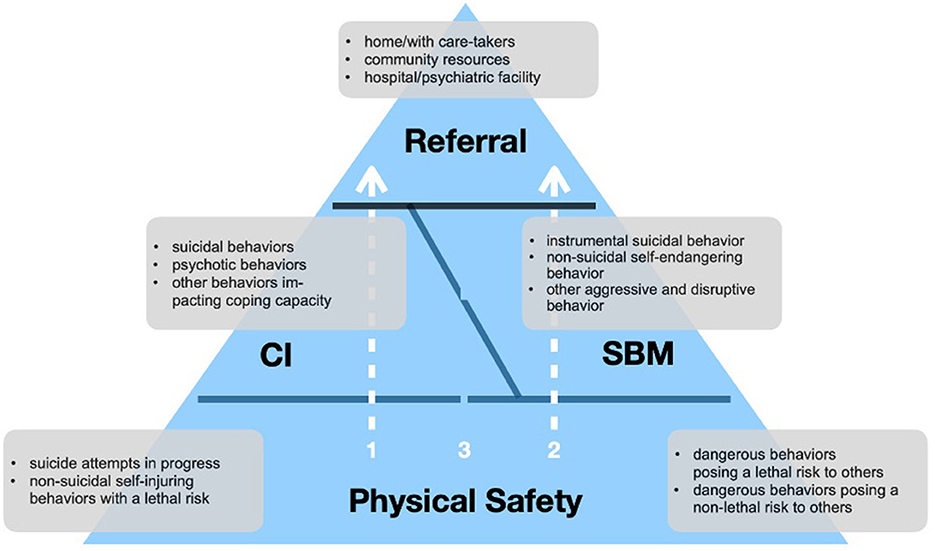- 1Independent Researcher, Aurora, ON, Canada
- 2University of Applied Sciences of Police and Public Administration North Rhine-Westphalia, Gelsenkirchen, Germany
- 3German Sports University Cologne, Cologne, Germany
A Correction on
Beyond one-size-fits-all: managing mental health calls with the integrated Behavioral Emergency Assessment and Response (iBEAR) model
by Zaiser, B., Staller, M. S., and Koerner, S. (2025). Front. Psychol. 16:1585009. doi: 10.3389/fpsyg.2025.1585009
There was a mistake in Figure 1 as published. The grey text box outlining behaviors associated with “CI” was inadvertently located in the area of “BM” and vice-versa. In addition, figure one states “BM” instead of SBM, as stated in the text. The corrected Figure 1, where the grey text box starting with “suicidal behaviors” is associated with “CI” and the text box starting with “instrumental suicidal behavior” is associated with “SBM”, as well as where “BM” has been substituted with “SBM”, appears below.
The original version of this article has been updated.
Generative AI statement
Any alternative text (alt text) provided alongside figures in this article has been generated by Frontiers with the support of artificial intelligence and reasonable efforts have been made to ensure accuracy, including review by the authors wherever possible. If you identify any issues, please contact us.
Publisher's note
All claims expressed in this article are solely those of the authors and do not necessarily represent those of their affiliated organizations, or those of the publisher, the editors and the reviewers. Any product that may be evaluated in this article, or claim that may be made by its manufacturer, is not guaranteed or endorsed by the publisher.
Keywords: behavioral emergency, person in crisis, crisis intervention, functional analysis, applied behavioral analysis, crisis response, behavioral health crisis, mental health crisis
Citation: Zaiser B, Staller MS and Koerner S (2025) Correction: Beyond one-size-fits-all: managing mental health calls with the integrated Behavioral Emergency Assessment and Response (iBEAR) model. Front. Psychol. 16:1721766. doi: 10.3389/fpsyg.2025.1721766
Received: 09 October 2025; Accepted: 10 October 2025;
Published: 21 October 2025.
Approved by:
Frontiers Editorial Office, Frontiers Media SA, SwitzerlandCopyright © 2025 Zaiser, Staller and Koerner. This is an open-access article distributed under the terms of the Creative Commons Attribution License (CC BY). The use, distribution or reproduction in other forums is permitted, provided the original author(s) and the copyright owner(s) are credited and that the original publication in this journal is cited, in accordance with accepted academic practice. No use, distribution or reproduction is permitted which does not comply with these terms.
*Correspondence: Benni Zaiser, Y29ubmVjdEBiZW5uaXphaXNlci5jb20=
 Benni Zaiser
Benni Zaiser Mario S. Staller
Mario S. Staller Swen Koerner
Swen Koerner